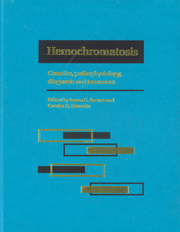Book contents
- Frontmatter
- Contents
- List of contributors
- Foreword
- Part I Introduction to hemochromatosis
- 1 A brief history of hemochromatosis
- 2 Hemochromatosis: a genetic definition
- Part II Genetics of hemochromatosis
- Part III Metal absorption and metabolism in hemochromatosis
- Part IV Diagnostic techniques for iron overload
- Part V Complications of iron overload
- Part VI Therapy of hemochromatosis and iron overload
- Part VII Infections and immunity in hemochromatosis
- Part VIII Hemochromatosis heterozygotes
- Part IX Relationship of hemochromatosis to other disorders
- Part X Animal models of hemochromatosis and iron overload
- Part XI Screening for hemochromatosis
- Part XII Hemochromatosis: societal and ethical issues
- Part XIII Final issues
- Index
2 - Hemochromatosis: a genetic definition
from Part I - Introduction to hemochromatosis
Published online by Cambridge University Press: 05 August 2011
- Frontmatter
- Contents
- List of contributors
- Foreword
- Part I Introduction to hemochromatosis
- 1 A brief history of hemochromatosis
- 2 Hemochromatosis: a genetic definition
- Part II Genetics of hemochromatosis
- Part III Metal absorption and metabolism in hemochromatosis
- Part IV Diagnostic techniques for iron overload
- Part V Complications of iron overload
- Part VI Therapy of hemochromatosis and iron overload
- Part VII Infections and immunity in hemochromatosis
- Part VIII Hemochromatosis heterozygotes
- Part IX Relationship of hemochromatosis to other disorders
- Part X Animal models of hemochromatosis and iron overload
- Part XI Screening for hemochromatosis
- Part XII Hemochromatosis: societal and ethical issues
- Part XIII Final issues
- Index
Summary
Early definitions of hemochromatosis
The definition of hemochromatosis, a disorder that causes iron overload, has undergone a great metamorphosis from the initial description of bronze diabetes in 1865 to the identification of a hemochromatosis gene in 1996. The original definition was a simple description of the two abnormalities that were noted at the time: skin pigmentation and diabetes mellitus. Six years later, the definition was modified to include the observation of iron deposition in a cirrhotic liver. In 1889, von Recklinghausen advanced the definition to emphasize the presumed pathophysiologic abnormality: iron from circulating blood accumulated in and caused pigmentation of the liver.
Definitions in the twentieth century
During most of the twentieth century, hemochromatosis was considered to be an idiopathic disorder. Some authors included in the definition a statement about possible causes of iron overload, such as an unidentified environmental effect, disordered copper metabolism, or alcohol abuse. Sheldon considered the possibility that hemochromatosis is an inborn error of metabolism. Prior to 1949, hemochromatosis was regarded as untreatable, because there was no known reliable therapy for iron overload or its complications. The first reports of phlebotomy therapy for hemochromatosis appeared at mid-century. By 1955, hemochromatosis was believed to be a rare idiopathic disorder of iron metabolism, primarily of middle-aged men, that caused heavy iron overload. Signs and symptoms included grey-green skin pigmentation, hepatomegaly, splenomegaly, ascites, diabetes mellitus, hypogonadism, heart failure, hepatic cirrhosis, and hepatocellular carcinoma.
- Type
- Chapter
- Information
- HemochromatosisGenetics, Pathophysiology, Diagnosis and Treatment, pp. 8 - 12Publisher: Cambridge University PressPrint publication year: 2000
- 2
- Cited by

